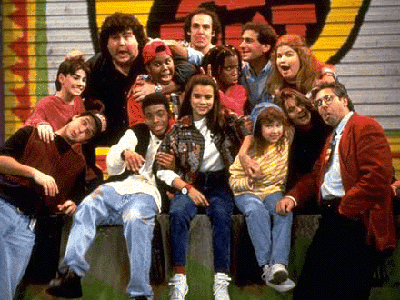
“I connected with All That because it refused to condescend to its audience. Though that was — and is — a rarity for most children’s television, it was very much in line with the high-quality programming Nickelodeon offered in the ’90s.” — Dustin Levy
Twenty years ago, a show righteously claimed it was “fresh out the box.” And while reflecting on All That is full of nostalgic goodness, 20 years is a pretty terrifying interval.
Despite All That premiering when I was only a little more than a year old, the Nickelodeon sketch show aimed at children was still a major part of my childhood.
Modeled as a kids’ version of Saturday Night Live, All That included featured players, weekly musical guests and recurring sketches just like the NBC staple. And All That offered me more than just weekly gags about a pea-loving cafeteria lady or Kevin the stage manager muttering “five minutes”; it let me easily identify with the show’s cast and sketches.
All That’s initial run, which began in 1994, spanned six seasons and featured teenagers who actually looked like teenagers, not the interchangeable actors currently over at The CW or even the extra-bubbly Disney Channel kids. Growing up with All That, I saw myself in cast members like the manic Kel Mitchell or the goofy Josh Server.
While the sketches on All That never amounted to anything beyond “children’s comedy,” they still were written more cleverly than most children’s shows. “Vital Information,” a skit in which Lori Beth Denberg would rattle off pointlessly silly statements “for your everyday life,” actually introduced dry comedy to children. (Yes, Danny Tamberelli took over at the desk for seasons five and six, but Denberg was unmatched in her hilarious deadpan readings.) I remember tensing with excitement whenever the “Ask Ashley” sketch came on — watching a tiny Amanda Bynes alternate between sugary sweetness and unhinged madness as she read letters from dimwits was a delight every time.
My other All That favorites included “Superdude” and “Good Burger,” the latter of which became a feature film starring Mitchell and Kenan Thompson, who is now an SNL cast member. All That spawned spinoff Nickelodeon shows such as Kenan & Kel, a sitcom starring Mitchell and Thompson, as well as The Amanda Show, which spotlighted Bynes’ talents.
In January, SNL hired Sasheer Zamata, its first black female cast member since Maya Rudolph, after heavy pressure from fans and critics. But diversity was never a problem on All That : The show’s original cast featured more nonwhite than white actors, a feat still difficult to achieve on television.
All That’s diversity was, significantly, never highlighted on the show, which was incredibly important in making millions of children more accepting. Because I grew up with All That, I never noticed the cast was a melting pot and the musical guests were often prominent black artists — TLC even performed the opening theme song. Subconsciously, I learned way more about races other than my own from All That than I could have experienced by exclusively watching Cartoon Network or the Disney Channel. As a result, All That is partially responsible for creating a more open, accepting audience.
All That ran for six seasons before cancelation in 2000. The show relaunched two years later with a new cast, but that largely forgettable era only highlighted the strengths of the show’s initial run, which many fans refer to as “the golden era.”
When I happen to catch All That on TeenNick’s “The ‘90s Are All That” programming block, I am always way more amused than my friends. Sure, looking back, the sketches understandably feel cornier, but because I know how much I enjoyed and anticipated the show as a child, that doesn’t really matter. I connected with All That because it refused to condescend to its audience. Though that was — and is — a rarity for most children’s television, it was very much in line with the high-quality programming Nickelodeon offered in the ’90s, of which All That was the piece de resistance.



